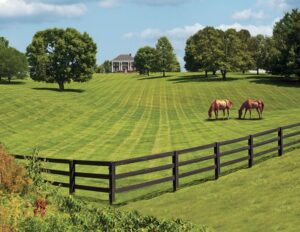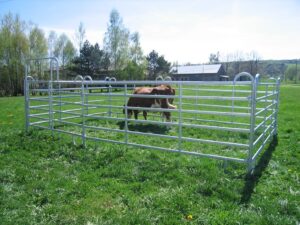The proper management of pasture is a significant factor in the stockraising and ranching sector. It is a matter of defined allocation of grazing areas and their subsequent preservation to achieve the most favorable outcomes for the animals. Among the many factors that can lead to a pasture management change, probably the one that has the ability to transform it is the use of livestock fencing. Livestock fencing is of great use as it brings along many benefits ranging from good grazing management to improved animal care. We will cover the advantages of using fencing for livestock, the different types of fencing that are used, the planning and design of a fencing system, the technicalities of installation and maintenance, the cost matters, and the stories of success from farmers and ranchers who have benefited from livestock fencing.
Benefits of Livestock Fencing for Pasture Management
Stock fencing is multi-faceted as it brings so many advantages to pasture management. It is also essential that the rotational grazing allows for better grazing management. Rotation grazing can be practiced by sectioning pastures with fencing and allowing animals to graze in small portions. This practice encompasses the process of regularly transferring animals from one section to another, letting the consumed grasslands recuperate while assuring the uninterrupted supply of green fodder for the animals. The rotational grazing method improves drought resistance, provides the plants with an even distribution of manure, and promotes better growth of the pasture.

Types of Livestock Fencing and Their Uses
There are a lot of livestock fencing types that are different from one another and have various features meant for different purposes. Electric fencing is the most common one, as it is a quite reliable and diverse option. An electric fence is one of the most popular fencing methods for protecting crops, as it discharges a low-voltage electric charge to keep animals from entering it. Electrified fencing is simple to build, and can also be moved or adjusted to meet the needs.
Another type often seen is woven wire fencing, where the horizontal wooden wires are woven together with vertical wires. It is a solid fence that allows for a vast number of livestock to be contained. Wire fencing is durable and enduring and therefore is best suited for areas where animals are densely settled.
This point is that high-tensile fencing is characterized by its strength and endurance. It consists of multiple strands of high tensile wire put from one post to another with neither sag nor break. Such fencing may be tightened and braced appropriately and this type of fencing offers the best containment for livestock.
Barbed wire fences are a low-cost solution that provides barbs on the wires. These barbs not only make the fence difficult to scale but also cause injuries to any perpetrator. As such, it serves as a repellent for wild animals caught in the process of crossing the fence. On the other hand, barbed wire fencing should be employed carefully, as it can cause harm of animals and humans if not carefully maintained.
Sheep or goats are commonly fenced in using mesh-wire fencing. It is a simple design that has small openings which in turn prevents the animals from getting their heads stuck and at the same time keeps them well-protected.
The split rail fence is the classic one which not only adds to the beauty of the pastures but also gives the farmers a sense of security at the same time. This affair is made up of wooden rails that are positioned between the posts horizontally. It might not be a complete containment measure but could be a good visual barrier or boundary marker.
Pip fencing is a strong and long-lasting kind using steel pipes as opposed to traditional wooden posts. It provides the best herding for larger livestock and sheds itself of the time required for the upkeep.
While selecting the precise fencing type to suit your unique requirements, the key considerations include livestock type, terrain of the pasture, and your budget.
Planning and Designing Your Livestock Fencing System
When planning a livestock fencing system, it is vital to perform a thorough pasture and livestock needs evaluation. Take into account whether the type and number of animals you have are compatible with each other and their behavior and grazing habits. This will allow you to evaluate and choose the appropriate size and configuration of your fence.
Secondly, work out the layout of the fence line onto a paper or a digital drawing. Consider any natural barriers or obstacles that could cause an issue with the placement of the fence. Think of the locations where water sources, shade, and shelter areas are available to make access to these areas easy for the animals.
Adequate gates and access points are another important consideration. Gates provide the convenience of either moving the animals from one pasture to another or welcoming the farm machinery on the property. Position gates in the strategic places which are the shortest way for the animals to travel and also to facilitate proper pasture management.
Installation and Maintenance of Livestock Fencing
Each section of livestock fence should be properly installed and regular maintenance will help it work properly and the fence system to last long. Do the site preparation by removing any miscellaneous objects that could be disturbing once the fence is erected. Make sure that the ground under you is level and no rocks or other disturbances ride it.
First execute posts and braces in a regular manner at the intervals of your fence line. The wire, timber, and plastic fence types or the combination will depend on the selected kind of materials. Posts made from wood are common but may need extra maintenance due to the fact that they wear out faster over time. Firerbers of the two, steel or fiberglass posts surpass durability but can be costly as well.

Afterward, you will place the posts, and the installation instructions probably be from the manufacturer. Then you get the fencing materials and extend and secure them per the instructions. Make sure you evenly weigh out the tension of the fence line along the whole fence to reduce sagging or weak places. The use of connectors or clips that are the right ones to attach the fencing material to the posts is recommended.
Routine inspection should be kept as the foremost rule for maintaining your livestock fencing. Check the fence periodically to find out whether it is broken, wobbly, or has loose blaming been done. Address any problems such as broken entryways or exit points for animals and entry points for predators in a timely manner. Moreover, has the grass cleared off the area surrounding the fence fence line in order not to hinder the fence’s protection capacity?
Cost Considerations for Livestock Fencing
Sheep fencing cost depends on a range of factors, some of which include the material used or the installed quantity. Material type, length of fencing material, and the type of pasture terrain contribute to the total price. Likewise, the labor costs allowance of the process tied to installation services by professionals should be factored in as well.
It is crucial to evaluate the initial financial outlay for livestock fencing from the perspective of not only short-term costs but also long–term cost savings and return on investment. Although capital costs may represent a burden at the outset, the level of quality combined with the proper installation and maintenance of the fenestration will generate savings in terms of time and money. Empowering farmers with productive pastures, reduced animal escapes, and better animal welfare will economically favor them more.
Different financing options, such as paying in installments over a certain period of time, may be provided to address the initial costs of grazing fencing. Research grants, loans, or cost coins offered by agricultural agencies of the organization or the government that support sustainable agriculture practices are examples of such activities.

Thanks for sharing. I read many of your blog posts, cool, your blog is very good.
Your article helped me a lot, is there any more related content? Thanks!
Can you be more specific about the content of your article? After reading it, I still have some doubts. Hope you can help me.
Your point of view caught my eye and was very interesting. Thanks. I have a question for you.
Thanks for sharing. I read many of your blog posts, cool, your blog is very good.